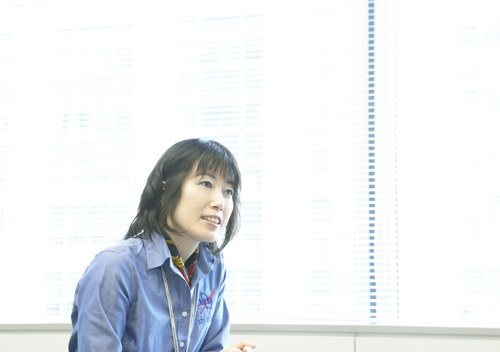
from Japan vol. 57 2011.06.01 EARTHLING Interview: Naoko Yamazaki (JAXA Astronaut)
![]()
In April 2010, JAXA astronaut Naoko Yamazaki fulfilled her childhood dreams. She traveled to space on the space shuttle "Discovery" and spent 2 weeks at the International Space Station. We asked her to share her thoughts on what will become of the relationship between man and space in the future, and what would be considered the new frontier in 50 year time frame.
目次へ移動 Standing face to face with Earth as a living being
---- Most people around the world have yet to travel to space. But when you think about it, you realize that Earth and where we are right now is a part of the same universe. So we've all been to space already. But then where does this feeling of "having gone to space" come from?
Yamazaki - You're exactly right. This is a part of the same universe. I remember how excited I was when I learned that our bodies, too, were made of the same substance as the stars in elementary school. Everything, in other words, we are all part of space. So going to space is not an accurate description. It's probably better to say "we are freeing ourselves from Earth's gravisphere."
---- What changes when you leave the gravisphere?
Yamazaki - It's completely "different." The space shuttle continues to accelerate until it exits the gravisphere. Then the engines are turned off and we find ourselves in zero gravity. Once you're in zero gravity, it's very different. I was sitting in the middeck of the space shuttle, and the windows were far away so I couldn't get a good look at Earth, but I immediately knew I was in "outer space" because of the difference in gravity. Then I went to the window and looked down at our planet. I was touched by how beautiful it was.
---- Was it just like you had imagined?
Yamazaki - I knew it would be beautiful, but it was truly breathtaking. I was blown away by what I saw. I felt it with all my 5 senses.
February last year, new windows called Cupola were installed in the International Space Station (ISS) to conduct observations of Earth. Our mission took place last April, so the windows were installed right before we got there. The Cupola is a domed shaped module big enough to be able to stick your upper body into with a planetarium like 180-degree view. It is positioned in a way that you feel as though you are standing on the side opposite from Earth, but when you get inside you can see the planet right above you. When you are on an airplane and see the landscape beneath you feel that you are really high up. But in space, there is no sense of up or down, so no matter what your posture is, it doesn't feel strange at all, but it is quite shocking to see the "Earth right above you." When you experience this, the feeling of "being in space" changes from just being somewhere up high. It is as though the space shuttle is standing face to face with a living being we call Earth, as though they were equals. I thought this was very interesting.
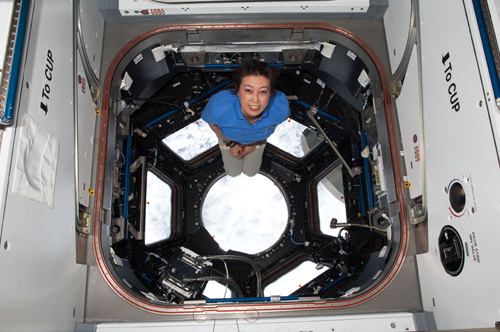 JAXA astronaut, Naoko Yamazaki inside Cupola as she looks up into the spacecraft. (Photograph: NASA)
JAXA astronaut, Naoko Yamazaki inside Cupola as she looks up into the spacecraft. (Photograph: NASA)
---- Do people fight with each other or express negative feelings in space?
Yamazaki - Yes, sometimes. But we all had a high sense of purpose, of accomplishing a mission as one unified team, and we were quite busy, so we couldn't really afford to fight (laugh). I have heard that when you spend an extended length of time up there, there may be misunderstandings and certain group dynamics may develop. That is why astronauts try to sit down and have a meal together every day no matter how busy they may be. Everyone made an effort to sit down to share a meal together.
---- So it's really just like a family (laugh).
Yamazaki - Exactly. I was on a 2 week mission, and the crew was very busy, so we couldn't sit down to eat all together every day. But we managed to share a meal 3 times during the 2 week mission. For our first meal together, an astronaut from Russia made a Russian meal for us, so the second time, Mr. Noguchi and I decided to serve everyone a Japanese meal - hand-rolled sushi. We had brought with us preserved food also used at the Showa Base in the South Pole, and cooked eggs and pork and rolled them up. Sitting down at the table and sharing a meal with everyone was the best part about being in space.
目次へ移動 A new era in which many people can travel to space
---- When you look up at the sky, you can see the ISS even from Earth. When you got there, what did you think was different?
Yamazaki - Well, there are people there. It seems a bit strange that people can go all the way up there. When you look up at the ISS, it looks like a star traveling across the sky. But this star is actually manmade and people live inside it. I am truly amazed by our capabilities.
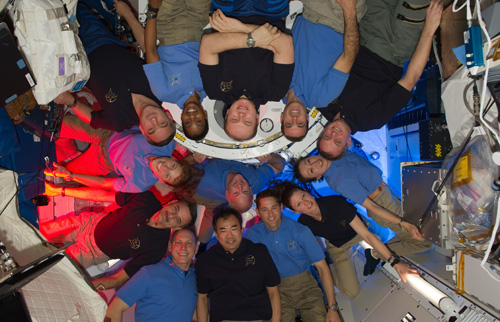 A group photo of the crew inside the Japanese Experiment Module "Kibo" at the ISS. (Photograph: NASA)
A group photo of the crew inside the Japanese Experiment Module "Kibo" at the ISS. (Photograph: NASA)
---- Many people may imagine the ISS to be an "ideal home" but there is a lot of noise, and you can't just open a window to ventilate, so it probably isn't all too comfortable. You used to study space hotel design, but what are your thoughts about comfort and the living environment at the ISS?
Yamazaki - We take the space shuttle to the ISS, but the cockpit of the space shuttle located at the very tip is extremely small. The middeck below is the living area where 7 astronauts live for 3 days until we get to the ISS. It's a small space, but we can use all four sides, so we didn't notice the size so much.
The ISS is much bigger than the space shuttle, so it was very comfortable. The middle area of the ISS is the living environment, and it is about twice the size of a jumbo jet. It is, however, a closed environment so it seemed like there was a lingering smell and it felt a bit dusty. In any case, it's a very manmade environment. There is some greenery, but that too is manmade, and you do get the sense that if you take one step outside this environment, you will die, and that the only livable environment is within the spacecraft.
---- People going to space. What this means is that they take the same environment as that found on Earth with them. With that in mind, how long do you think it would be before people can live in space?
Yamazaki - I hadn't expected life in space to be so normal. You get up in the morning, wipe your face, brush your teeth, eat meals, work, sleep in a sleeping bag... you begin to develop a routine, and life in space begins to feel quite ordinary. From this aspect, we might be living in space quite soon. Even now, there are people living in space 6 months at a time. I think the bigger questions would be when would a larger number of people begin living in space. It would first begin with suborbital flight. You would go up and then come back down. Then you would make a low orbit at around a height of 400km. For people to start actually living up there... may take another 50 years.
---- If there is a reason for us to have to live up there, it may even be possible in about 10 years.
Yamazaki - True. Another thing I thought was interesting was that when you are far away from Earth, you begin to understand it better. Leaving our homes, leaving our home planet provides a great opportunity to rethink a lot of things, and the ISS is like a miniature Earth. There are people from many different countries, and we recycle water, even our urine into water, and also recycle the air as much as possible. We depend on replenishments for food, but technologies developed to sustain life in the ISS will also be useful for our planet.
目次へ移動 2 types of missions in the space frontier
---- Demand for astronauts, how do you think this will change in the future?
Yamazaki - If you think about what our mission in space would be in the future, I think there are 2 types of roles astronauts will be expected to fulfill. One is expanding the frontier. Space shuttles and the ISS orbit the Earth at a height of 400km, which is still quite low. But in the future, we may be going father more frequently, to the moon, to asteroids, Mars, or even farther, and exploring new frontiers.
Another direction is working closer to Earth from the low orbit ISS or may be there will be another space station in the future. Many more people may be able to travel to space for leisure and stay for a long time.
As for low orbits around Earth, I am sure there will be more private investment and cooperation, and the doors will be opened even wider. Exploring new, farther frontiers will most likely be a government-led project. Going to Mars and back will be a mission that will take many years. Even greater mental strength and willingness to cooperate will be required. You also have to monitor your own health, so I am sure there will be a need for astronauts with a strong medical background. To explore Mars or the moon, you may need experts on geology. I think that the needs will be different depending on the mission.
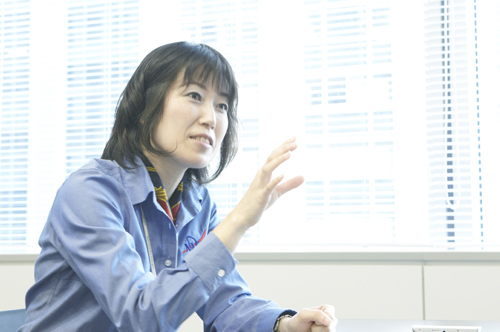
---- I feel that something will change when people who aren't scientists or engineers travel to space.
Yamazaki - I think so, too. Astronauts in both Japan and the US are required to have graduated with a degree in science, but I hope this will change in the future. I think especially, if someone with an artistic eye went to space, they would be able to communicate about even a wider range of things, and this might give way to a new culture. I think that a change like that may happen in the next 50 years.
---- For many people to start traveling to space, you need much more than just technology, right?
Yamazaki - Yes. Until now, in a way people were incorporated as part of the whole system, and it was a bit mechanical, but if people with a wide range of unique characteristics start being able to travel to space, the model will have to change. The Earth's environment is truly variegated and so it provides numerous margins. Even if the ISS becomes a little bigger, it is still a manmade environment, and there is only a critical level of resources, so if one thing goes wrong, it immediate starts affecting our lives. Even if we have many many countermeasures, the dangers we face up there are incomparable to those on Earth. That is why I find it very interesting to see how people will be able to actually start living in a spaceship, give birth, and spend their entire lives up there.
---- An unparalleled frontier project may require a different, unique essence lacking from ordinary project management. What knowledge runs common to all astronauts? Is it leadership and followership? Is it curiosity? You have met many astronauts, but what skills do you think astronauts have in common?
Yamazaki - Actually astronauts all have unique personalities, and they are very different from one another. But I think that we all have a common essence, which is probably the ability to make decisions. Our ability to prioritize and act. We know that something is bound to happen. Anything can happen in space. But we remain composed even if something does happen. I think we all have a clear vision of a safety net or a minimum line that we want to contain the event within. For example, we tell ourselves, no matter what happens we will come back alive or we're going to keep the ISS going. Keeping that minimum line in mind, we write certain things off or prioritize things at times very stoically. So I guess the ability to make such decisions.
目次へ移動 Exploring the frontier means to head towards and challenge the unknown
---- Where do you think your frontier lies?
Yamazaki - If you think about frontiers in a straightforward way, it would be going farther, but I feel that it's not about physical distances. I think for me the frontier is the unknown and what's important is to keep exploring and challenging such frontier.
In this sense, the frontier for me is making it possible so that not just a small group of people, a single space family, but many more people can travel to space. This will help expand our active territory, and we will realize that "people's potentials are boundless." I don't think we can call it a frontier if only a certain group of people can go. The trip just ends up being an adventure.
In the end, more and more people, even the entire human population may start considering going to space. Whether its space or other fields, what matters in the end are people's feelings. It's the people who make the technology and systems. So I hope that we all will be able to reexamine our ties and explore new possibilities. This also applies to myself as I, too, have a lot of work ahead.
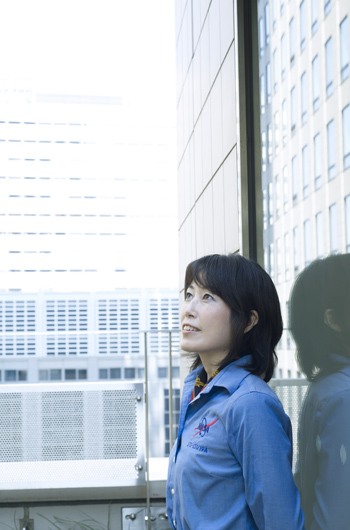
Naoko Yamazaki
Born in Chiba in 1970. After graduating with a Master of Science degree in Aerospace Engineering in 1996, she joined NASDA (currently JAXA) and began working on the development of Japanese Experiment Module "Kibo." In 1999, she was selected as an astronaut canidate. In 2006 she was certified as the NASA Mission Specialist (MS). She travelled to space on the space shuttle "Discovery" in 2010 to take part in the ISS assembly mission as an MS. Currently she is involved in aerospace engineering research at the University of Tokyo.
Interviewer: Naohiko Kohtake (Associate Professor at the Keio University Graduate School of System Design and Management Institute)
Edited by: Tami Okano (Think the Earth Project)
Translated by: Yuri Morikawa (oxygen inc.)
Photograph: Kenta Yoshizawa















